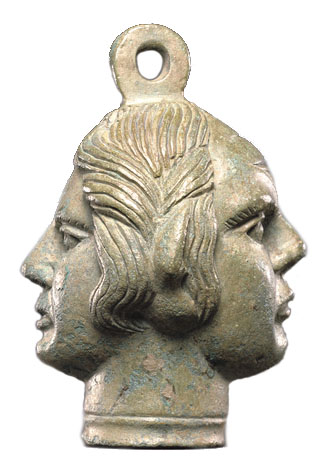
-
Copyright credit: J. Paul Getty Museum

ARCHAEOLOGICAL DESCRIPTION OF THE WEIGHT
Authority
Mint
Denomination
Material
Copper alloy (bronze or brass)
Manufacture
Cast
Shape
Human bust or head
Length
6.83 cm
(2.6875 inch)
Width
4.60 cm
(1.8125 inch)
Height
4.45 cm
(1.75 inch)
Metrology
| Mass (g) | Mass (grain) | Date of measurement | Reference | fragmented | cleaned | reference weight |
|---|---|---|---|---|---|---|
| 332.48 | 5131.0006787151 | - | www.getty.edu | No | No | Yes |
Iconography
| Symbol | Technique | Direction | Position | Number | Synecdoche |
|---|---|---|---|---|---|
| Satyr | Shaped | Head | |||
| Maenad | Shaped | Head |
Wear
Corrosion
Handle
No
Suspension hole
No
Recarved mould
No
Recarved weight
No
Intentionally destroyed
No
Archaeological description
A double herm of a satyr and maenad is formed of two half-heads joined back-to-back on a single neck, at the base of which is a shallow cavetto molding. The male head has asymmetrical features, with one eye set lower than the other, a deeply creased forehead, and a receding hairline. A pair of pointed ears emerge from between coarsely grooved locks of hair, identifying the figure as a satyr, a follower of Dionysos. His female companion has more regular features; at the center of the forehead is a short fringe of hair that falls in soft waves to either side of the face. Both faces have incised pupils and vertical incisions along the brow ridge.
The double herm was hollow cast in bronze and filled with lead, and is fitted with a suspension loop at the top, indicating that it served as an aequipondium, or counterweight for a steelyard scale. Similar to mechanical scales still in use, the instrument consisted of a tray for objects hanging from one end of a calibrated beam, along which differently sized weights on hooks slid until the arm balanced. Like the later weights found in great quantities at Pompeii and other Roman sites, Etruscan weights were carved of stone or cast in metal in the form of animals, human heads and busts, or mythological figures, as well as plain spherical and pyramidal shapes. Closely comparable to this counterweight are a pair of hanging weights (two maenads, satyr and maenad) from the Fucoli sanctuary near Chianciano Terme, dating to the fourth century B.C.
The double herm was hollow cast in bronze and filled with lead, and is fitted with a suspension loop at the top, indicating that it served as an aequipondium, or counterweight for a steelyard scale. Similar to mechanical scales still in use, the instrument consisted of a tray for objects hanging from one end of a calibrated beam, along which differently sized weights on hooks slid until the arm balanced. Like the later weights found in great quantities at Pompeii and other Roman sites, Etruscan weights were carved of stone or cast in metal in the form of animals, human heads and busts, or mythological figures, as well as plain spherical and pyramidal shapes. Closely comparable to this counterweight are a pair of hanging weights (two maenads, satyr and maenad) from the Fucoli sanctuary near Chianciano Terme, dating to the fourth century B.C.
Autopsy
No
INSCRIPTION
| Language | Technique | Legend type |
|---|
Fac simile
Edition
Monogram
ARCHAEOLOGICAL CONTEXT
Findspot (region)
Findspot (site)
context
CIRCUMSTANCES OF ACQUISITION
Region
City
Date of first acquisition
circumstances
Gift of Barbara and Lawrence Fleischman (New York, 1925 - New York, 1997) to the J. Paul Getty Museum in 1996. Sold to Barbara and Lawrence Fleischman in 1990 by Robin Symes.
DATING OF THE WEIGHT
Curatorial Section
GREEK
Time frame
Comments on Chronology
3rd - 2nd century B.C.
COLLECTION HISTORY
Collection
| Name | Date of acquisition | Inventory number |
|---|---|---|
| Fleischman Collection | Jan. 1, 1990 | F247 |
| Getty Museum – Getty Villa (Malibu) | Jan. 1, 1996 | 96.AC.133 |
| Symes Collection | None |
Bibliography
| Reference | Page/Column | Reference (number) | Plate / Figure | Comment |
|---|---|---|---|---|
| True and Hamma 1994 | 180-181 | 84 | ||
| Getty Museum 1997–98 | 65 |
VARIA
Additional comment
Etruscan weight, Etruria.
Permalink